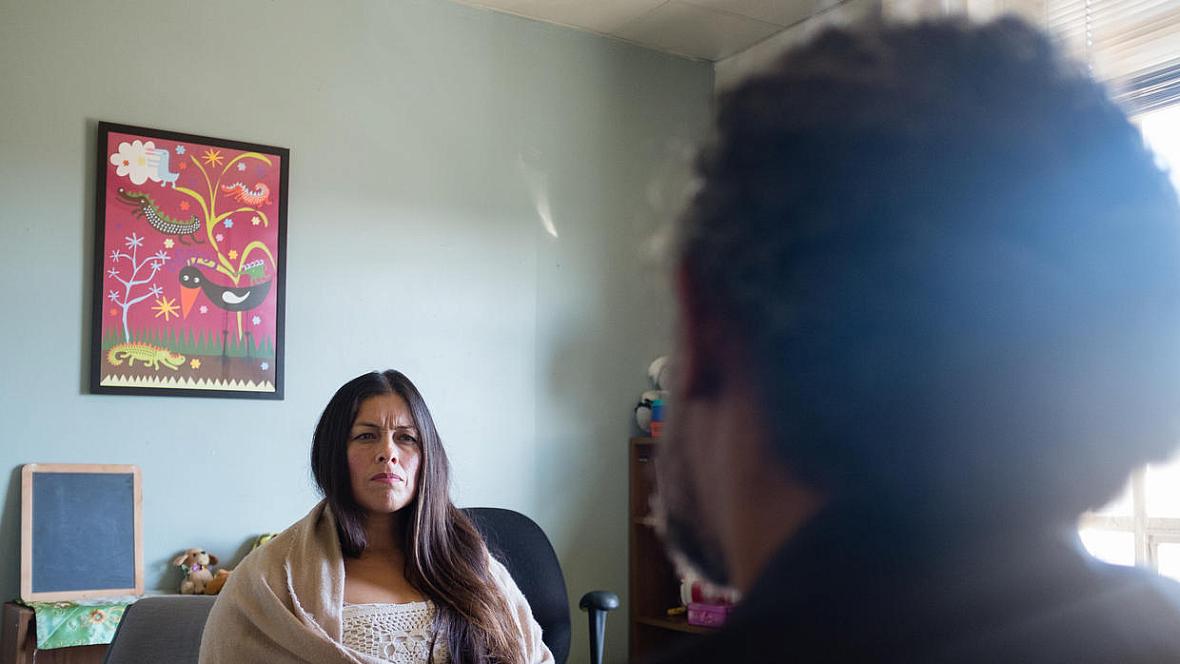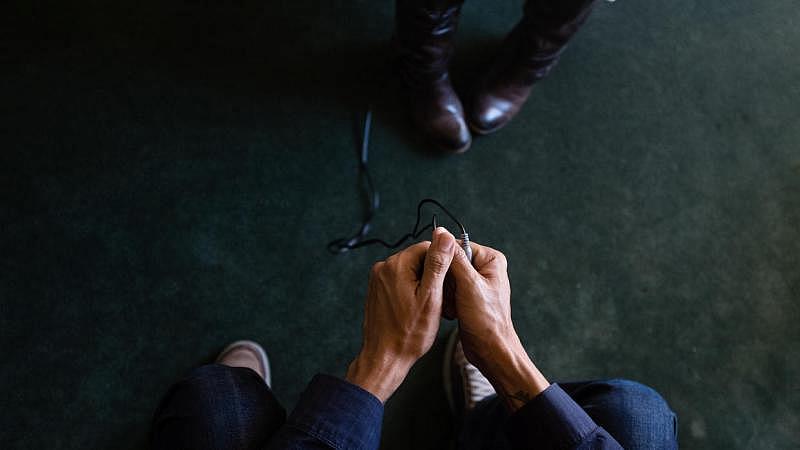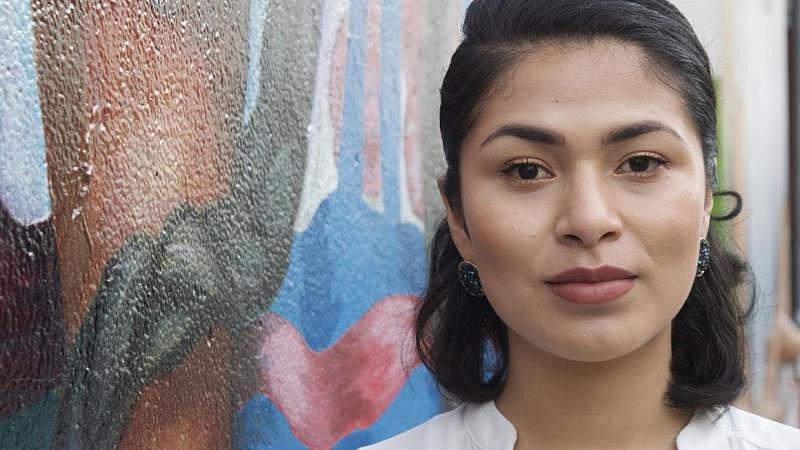Therapy used for U.S. veterans finds success among traumatized immigrants
This report was produced as part of the 2016 National Fellowship, a program of USC's Center for Health Journalism.
Other stories in the series include:

With his wife, Michelle. | Anna Clare Spelman
Click HERE for Spanish version.
Once used almost solely to treat post traumatic stress in war veterans, EMDR has slowly become an effective therapy to treat a range of traumas, including those experienced by immigrants. Now, more therapists in California are seeking training in EMDR to help patients process memories and heal, including in their native Spanish.
Today, Abad says he’s completely transformed from the days when suicidal thoughts weighed on him. He’s now remarried and seeks to help the undocumented community.
“Trauma is an opportunity to get healthy and come out even better than before, stronger, more self-confident,” Abad said.
Confronting the monster
For many, immigration comes with a number of lasting challenges and traumas. Women may arrive after having been abused at home or along the migrant route. People suffer a range of emotions after leaving their homelands and separating from family. Many confront racism and discrimination when they arrive in the land of the American Dream.
Jesús Solorio, 44, a couples and family therapist who has undocumented family members, said he’s heard too many horrible stories to count.
“I have several clients who were kidnapped when they crossed the border and forced into prostitution,” he said. “There are also young people who fled the drug cartels in Central America, but many are attacked once they get here.”
Once they’re in the United States, many immigrants ignore their emotional experiences or the stress of the journey, focusing instead on trying to make a life. But the memories almost always come back.
Abad left Mexico when he was 19, with his two sisters, who were nine and 11 years old.
“It's dehumanizing and traumatizing,” he said. “When you're about to cross the border, you start to think of yourself almost as an object. You're no longer a person. You're prepared to lose a little of your dignity.”
Once in Texas, he lived with his sisters in an unfurnished house with 60 other immigrants. They eventually reunited with their mother in Chicago, who was working in a factory that made screws. Abad remembers that she was required to ask for permission when she wanted to eat or go to the bathroom.
Eventually, Abad began to study English. He moved to California and graduated from the film program at San Francisco State University. But the fears never left him. Nightmares occasionally woke him up in the middle of the night.
His reality affected his family, too. His young son learned to be alert to police whenever his father was driving. He knew Abad changed his name from time to time to find work.
After experiencing suicidal thoughts in 2014, Abad realized he needed to focus on facing some of his older traumas and processing the experience of immigration.
I am desperate. I feel I won't live past this weekend. – Abad
“EMDR therapy lowers the intensity of emotions through eye movements,” said Michelle, who is among a growing number of Hispanic psychologists using the therapy to treat undocumented migrants in California. “It allows us to go to that side of the brain where we store the memories, thoughts or traumas that we don't want to face.”
EMDR therapy was discovered in 1987 by U.S. psychologist Francine Shapiro as she watched the leaves of a tree. She noticed that her eye movements appeared to diminish the negative emotions associated with her own harrowing memories. That's known scientifically as bilateral stimulation, produced by eye movements that are guided by a scanner or a light, as well as sensors that send impulses to the hands in order to activate parts of the brain or headphones that produce alternating sounds for the left and right ears.
Michelle met Abad in 2015, and they soon married. Although Michelle does not treat Abad, he says she has been crucial to his healing process.
“EMDR allows you to release emotions just like the brain does naturally during the course of the day,” she said. “When we suffer a trauma, it is natural to avoid things that hurt us … This therapy is like taking people by the hand and helping them confront the monster that they've been fleeing from all their lives.”
Hispanic therapists
California has the largest number of agencies that train therapists in EMDR, according to the Humanitarian Assistance Program (HAP), which seeks to improve access to this therapy in poor communities. Other institutes also offer training, including the EMDR International Association and the EMDR Institute, founded by Dr. Shapiro.
Psychologist Priscilla Marquis, a HAP trainer in the United States and Latin America, says the Bay Area has seen a lot of interest among Latino therapists, including those who want to learn to administer EMDR in Spanish. Up to 20% of those who take EMDR trainings in the Bay Area are Latino. In Fresno, in the central valley, that number is 50%, according to Marquis.
Marquis was co-author, along with Steven Marcus and Caroline Sakai, of a 1997 study with Kaiser Permanente that found EMDR therapy to be more effective than traditional personal therapy, the use of medication or group therapy. The study of 67 persons with post traumatic stress disorder over three to six months showed that a relatively small number of therapy sessions resulted in substantial improvements that endured over time.
"If you're undocumented they treat you terribly," Abad said. And that makes you start "to lose your dreams." Anna Clare Spelman
EMDR training is offered to mental health professionals, social workers, therapists, psychologists and psychiatrists and requires two three-day sessions. Trainees must then complete 20 hours of client consultations, which are videotaped and reviewed by a supervisor, and a minimum of 50 hours of clinical sessions. The process can take up to a year because not all traumas are responsive to EMDR, either because they are very deeply rooted or because the patient is not ready to confront such vivid memories.
In private practice, EMDR therapy can cost anywhere from $70 to $200 for a single session. In California, many Hispanic therapists work through non-governmental organizations or state agencies that frequently have long waiting lists.
Treating those in the undocumented community also requires therapists to specialize in immigration trauma, Marquis said. “We will always need more bilingual people who have empathy and a cultural connection with patients.”
Solorio knows about the empathy that is required. Born in Los Angeles, his parents and five older sisters came from Michoacan, Mexico. As he grew up, he learned the interconnected difficulties of being an immigrant and how those stresses can cause trauma in many generations.
“If we don't educate people about issues like the diversity of the communities we serve, many psychologists might not understand why people are afraid to be treated, why they don't want to give their names and why a diagnosis of depression can be confusing when they can barely recognize sadness,” Solorio said.
He offers EMDR therapy as part of his training and certification program under the La Familia Counseling Service in Hayward, a city of 150,000, where 40% of the population is Latino. The service receives county funds to help Spanish-speaking clients who are covered by Medicaid or do not have health insurance.
Solorio says there is a need for more therapists who can understand patients in their native language.
Half the people he serves are undocumented or in the process of applying for visas like the U visa (for victims of mental, physical or sexual abuse) or the T visas (for victims of human trafficking).
The La Familia program offers therapy for up to six months. Immigrants without insurance can then shift to community services that increasingly fit their cultural and ancestral backgrounds.
Solorio, Michelle and other therapists who work with the Hispanic community often recommend their patients try additional spiritual practices, recognizing that many immigrants were raised with that kind of wisdom in their native countries.
“We Latinos are connected to the body in ways that are different from other communities. We complain that something in the chest or the stomach is bothering us, but perhaps those are symptoms of depression or anxiety,” Solorio said. “I refer many of my patients to yoga or dance groups, and I even use drums in my therapy.”
'UndocuHealing' and the road to community healing
Reyna Maldonado, 24, was born in the Mexican state of Guerrero and crossed the border with an uncle when she was six years old, leaving behind her grandparents and their farm. In California she reunited with her mother, who worked long hours while she spent her after-school hours in a small room, alone.
“When I grew up I realized how the problems that affected me emotionally manifested themselves physically, and at the age of 17 I met some traditional healers from Mexico who started to treat me,” Maldonado said. “That's when I started to think, 'OK, we don't have access to therapy, but we do have our indigenous traditions.”
A dark skinned woman with lively eyes, she is now enrolled in ethnic studies at Mill College in Oakland, and has been paying for her semesters with scholarships and crowdfunding campaigns.
Late last year, Maldonado and José Arreola founded the UndocuHealing Project, a holistic healing space for undocumented immigrants modeled after the Bay Area Healing Clinic Collective, where immigrants rights activists, traditional healers and mental health professionals offer “community healing” sessions.
The first session was held a few weeks after Donald Trump won the November presidential election, because “there was a lot of fear, anxiety and anger in many communities around the country,” she said. “In Oakland, we brought in a traditional healer and a grandfather who gave sessions on how take care of yourself in difficult times.”
One of the event’s healers, Alejandra Olguín, said she has seen how immigrants who left their homes many years ago “reconnect with their land” by just smelling plants like rosemary. “A woman from Oaxaca once told me that by smelling plants she remembered that as a child her grandmother took her to the river to throw in white flowers and leave their sadness there,” she said.
Next, UndocuHealing plans to build a database of state services available to undocumented migrants in order to “connect them with local healers through free or low-cost services,” Maldonado said. They are currently seeking funding.
For her part, Maldonado undergoes frequent sessions of “somatic therapy” with a Hispanic woman who offers private lessons in a small room in the Women's Building in San Francisco.
I deserve to be here. I have all the rights to a life even though I am undocumented. – Maldonado
That’s a combination of traditional therapy with physical exercises that stress “the crucial role of the body in the structure and process of the psyche,” according to the California Institute of Integral Studies, which offers accredited studies in Somatic psychology. It allows patients to explore how breathing, body movements, postures, gestures and other physical expressions shape a person's identity and sociocultural relationships.
Reyna Maldonado, 24, was born in the Mexican state of Guerrero and crossed the border with an uncle when she was six years old. Jenny Manrique
“She was very important for me, because as a Latina she is someone that I can identify with,” Maldonado said about her therapist. “I had one Anglo therapist who told me that I was shying away from better jobs, without understanding the limitations of being undocumented.”
Through her somatic therapist, Maldonado learned to accept that she's not to blame for her immigration status, and that much of the responsibility falls on the system that forces people to flee their countries. “I deserve to be here. I have all the rights to a life, even though I am undocumented,” she said.
She now lives in the Mission district of San Francisco with her parents, two younger sisters, her partner and six uncles and cousins. Only three are documented. Her mother sells tamales on the street and her father has lost two jobs because he doesn’t have a Social Security number. Now they fear raids by U.S. Immigration and Customs Enforcement.
“UndocuHealing wants to be ... a space where we can talk about what affects us, and we can take care of each other,” she said. “In these chaotic times, what we really need is a community.”
A cafe for hope
Now, Abad and Michelle are creating a unique space for providing healing services to the immigrant community.
As he arranges the furniture in a modest but colorful room in Fruitvale, Abad explains that they want to offer healing, drumming and talking circles, as well as free EMDR.
More than half of Fruitvale's population is Hispanic. An estimated 70% are undocumented.
“Being undocumented carries a lot more problems than you expect, and there are many things that you never talk about,” Abad said. “A people with a low self-esteem is a people that can be easily exploited.”
Michelle agrees. “Many undocumented migrants have received death threats. If there's trauma, if there's depression, if they are struggling with their mental health, there is no strength to resist,” she said.
In a couple of weeks, Abad will start to meet in the cafe with other undocumented immigrants. He will listen to them talk about the immigration-related traumas they suffered. And he will tell them there's hope -- that there's always hope.
[This story was originally published by Univision.]

